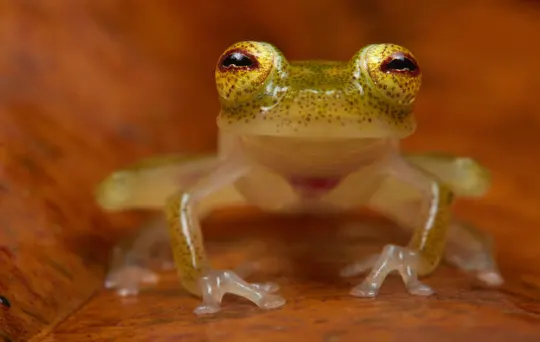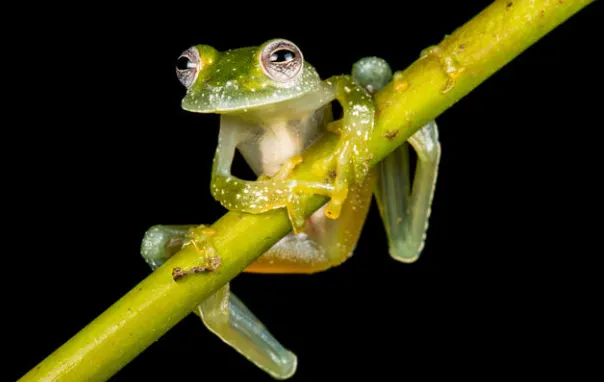Imagine encountering a creature so translucent that its internal organs are visible to the naked eye. This isn’t science fiction but the fascinating reality of the glass frog, a remarkable amphibian native to the lush rainforests of Central and South America.
Table of Contents
A Peek Inside: The Transparent Wonder
The glass frog, scientifically known as Centrolenidae, is a small, delicate amphibian whose most striking feature is its translucent skin. This transparency, particularly on the underside, reveals the frog’s internal organs, including its beating heart and, in some species, eggs within the female’s body. This unique characteristic makes the glass frog a living lesson in biology, perfect for curious minds eager to explore the intricacies of nature without the need for dissection.

Habitat and Lifestyle: High Climbers of the Rainforest
Glass frogs are arboreal, spending most of their lives high in the trees above mountainous streams in tropical rainforests. These frogs thrive in regions stretching from southern Mexico through Central America to the northern parts of South America. They favor habitats with abundant moisture, which is crucial for their breeding and survival.
During the dry season, glass frogs remain in the treetops, far from ground-level predators. However, the arrival of the rainy season triggers a fascinating descent. The frogs climb down to stream level to engage in their breeding rituals, making high-pitched whistling sounds to attract mates.
Unique Adaptations: Masters of Disguise
The translucent skin of the glass frog is not just for show; it serves as a vital adaptation for survival. By blending into their leafy surroundings, glass frogs can evade predators such as birds, snakes, and small mammals. Their skin allows light to pass through, softening the frog’s outline and making it less noticeable. This camouflage is particularly effective when they rest with their legs tucked close to their bodies, reducing visibility to potential threats.
Reproduction: Guardians of the Next Generation
Glass frogs exhibit fascinating reproductive behaviors. During the mating season, males position themselves on leaves overhanging streams and call out to females with their distinctive whistles. Once a female lays her eggs on the leaf, the male fertilizes them and assumes the role of guardian. For up to two weeks, he watches over the clutch, defending it from predators like wasps and frog flies, which lay their eggs on the frog’s clutch. The male’s protective behavior ensures that many of the tadpoles survive to drop into the stream below and continue their development.
Threats and Conservation: A Fragile Existence
Despite their enchanting appearance and fascinating behaviors, glass frogs face significant threats, primarily from habitat destruction due to rainforest deforestation. Human activities, including agriculture and illegal pet trade, have contributed to the decline of several glass frog species. Currently, around one-third of the known species are considered threatened, underscoring the urgent need for conservation efforts.
Efforts to protect glass frog habitats are ongoing in various countries, with conservationists working tirelessly to preserve these delicate creatures and the ecosystems they inhabit. The future of glass frogs depends on our ability to balance development with environmental stewardship, ensuring these transparent wonders continue to enchant future generations.

Fascinating Facts About Glass Frogs
- Leaping Legends: Glass frogs are incredible jumpers, capable of leaping more than ten feet in a single bound to escape predators.
- Long Lifespan: If they evade predators and thrive in their environment, glass frogs can live up to 14 years.
- Communal Creatures: Despite their solitary habits, glass frogs can often be found in small groups, especially during mating season.
- Guardianship: Male glass frogs exhibit strong parental care, protecting their offspring from various predators until the tadpoles hatch.
- Nocturnal Nature: These frogs are nocturnal, spending their nights hunting for insects and their days hidden in the forest canopy.
- The Glass Frog: A Symbol of Nature’s Fragility
The glass frog, with its delicate, transparent beauty, reminds us of the intricate and fragile web of life in our rainforests. Its presence underscores the importance of conservation and protecting our planet’s diverse species. By learning about and supporting efforts to preserve their habitats, we can help ensure that the glass frog continues to thrive in the wild.
Whether you’re an aspiring herpetologist or simply a nature enthusiast, the glass frog offers a fascinating look into the wonders of the natural world. Its unique adaptations and behaviors provide valuable insights into the complexity and beauty of life in the rainforests.
- Enchi Ball Python: A Unique and Stunning Morph of Python regius - March 27, 2025
- Emerald Tree Monitor: The Enigmatic Green Guardian of the Rainforest - March 26, 2025
- The Egyptian Cobra (Naja haje): A Fascinating Serpent - March 25, 2025
